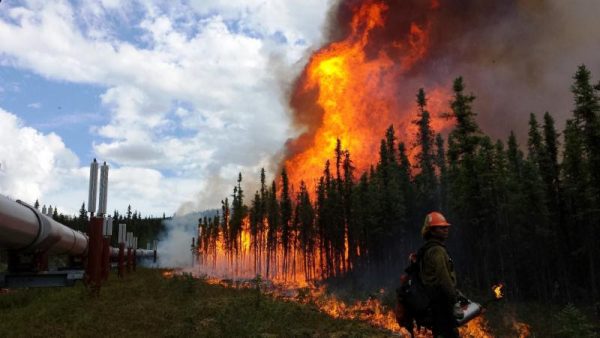Climate change boosts risk of extreme wildfires
December 16, 2016
Jeff Richardson
907-474-6284

University of Alaska Fairbanks scientists are presenting their work at the American Geophysical Union’s fall meeting in San Francisco this week. Here are some highlights of their research, as shared at the world’s largest Earth and space science meeting.
A newly published report concludes that climate change has strongly increased the prospects of a massive wildfire season like the one Alaska experienced in 2015, when 5.1 million acres burned throughout the state.
The study, which included the work of eight University of Alaska Fairbanks researchers, was part of a special report that was released at the AGU fall conference on Thursday. The Bulletin of the American Meteorological Society compiled the report, which concludes that climate changed increased the likelihood of a variety of 2015 weather events, such as a drought in Western Canada, flooding in Florida and record-high temperatures around the world.
The Alaska wildfire study looked at the probability of climate change contributing to another fire season on the scale of 2015, which was the second-largest since records began in 1940. It concluded that climate change has increased the risk of a fire year that severe by 34-60 percent.
The study gauges wildfire risk with an established formula used by the Canadian government that includes data about temperature, humidity and precipitation. It’s been proven reliable for boreal regions such as those in much of Alaska, said Uma Bhatt, a professor in the UAF Department of Atmospheric Sciences and a contributor to the study.
Researchers plugged data into the formula using a “pre-industrial” climate model without human-caused greenhouse gases. It also ran a separate simulation using NOAA projections for climate change that have accurately predicted sea ice loss in the Arctic, Bhatt said.
The model predicts that Alaska temperatures will rise by 1-2 degrees Celsius by 2050, added warmth that will offset an anticipated 15-30 percent increase in precipitation. It does come with significant uncertainty, however, since it’s based on a single model and doesn’t factor in the still-unknown effect of climate change on major lightning events that spark many wildfires.
The study was a collaboration between many Alaska researchers. James Partain Jr., the Alaska Region Director for NOAA Climate Services, was the lead author. It also included participation from the Alaska Fire Service, the University of Alaska Anchorage and National Weather Service.
UAF researchers contributing to the report included Robert Ziel, Alison York, Scott Rupp, Peter Bieniek, Brian Brettschneider, John Walsh and Rick Lader.
The full report is available online at http://bit.ly/24h3ZXo.


